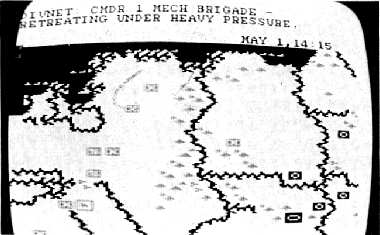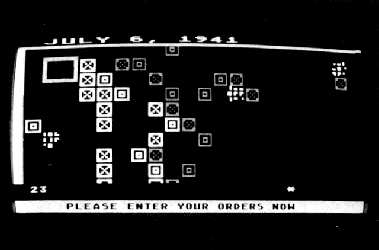THE
WAR ZONE
By BOB COCKROFT
By BOB COCKROFT
Nato Commander is a game from MicroProse Software that simulates the position of the leader of the Nato forces at the out-break of a fictional European war. Armour, infantry, helicopters and aircraft are at your disposal, but skill will be your best weapon. As commander your goal is to bring the war to a quick and successful conclusion. This game combines fast action and a combat system that provides many tactical opinions, to produce an interesting and exciting game.

What makes this such an interesting game is its ability to use the advantages of a computer over conventional board games to depict the war from the point of view of the NATO Commander. For example, you as the NATO Commander cannot see Warsaw Pact (WP) units that are not near your own. In other words, the opposition units are able to move undetected unless the NATO forces have some means of seeing them. This not only adds to the realism of the situation, but also provides for the possibility of suprise thrusts on weak sections of the front. In addition, the strength of (WP) units is not known. Even after repeated attacks on a WP units it is not known how badly it is damaged. This furthers realism by adding to the uncertainty of battle.
NATO Commander uses accelerated real time. There are no turn sequences in this game only continuous action as would be expected in a real battle. A player simply moves and attacks as the war goes on. Accelerated real time furthers realism by eliminating the long and boring turn sequences of board games. In addition, news bulletins from the war are displayed at the top of the screen continually. By reporting the situation of various units a player is able to know what is going on in all areas of the front. Moreover the reports make the game more dramatic, giving it an almost movie like effect. It is like one listening to incoming radio reports concerning the situation at the front. Even more, at the end of each day the computer gives the player a full screen report on the day's events. I find this an original and exciting technique for summarizing a player's progress.
One of the big problems I have always had with many war games is their inability to allow many types of alternative strategies to exist. With some games, every time you play them the same thing happens because there are no realistic alternatives for each side. This game does not suffer badly from this problem. I have played this game many times and have not had exactly the same battle twice. However, I have noticed some noticable patterns. But these patterns are not overly pronounced and therefore do not detract from the game very much. In addition, there are five different scenarios to choose from which tend to increase alternatives and therefore this problem.
The graphics are very good, but not excellent. The battlefield consist of a scrolling map of West Germany and parts of the surrounding countries. Units are clearly recognizable using standard idenification symbols. For example tanks are idenified with circles and infantry with crosses. The only complaint I have with the graphics concerns the detail in which the ground features are drawn. The map just doesn't seem to be made with the artistic creativity that I would associate with "excellent graphics". However, this is very minor and should not hinder a player's enjoyment of the game.
The computer controlled Warsaw Pact forces operate with a good degree of "intelligence". What this means is that they do not move in predetermined and systematic patterns. The units seem to have some flexiblity. (WP) units are able to adjust their strategy to intelligently meet the situation. In addition, NATO units have some ablity to function independently of a players control. For example, a unit will automatically choose its own path from their current location to the position assigned by the MOVE/HERE command. While doing this they will not only try to avoid (WP) units, but also begin to prepare their defence as soon as they reach there destination. This "intelligence" enables the human player to avoid the time consuming details which would normally be performed by the unit commander in a real situation, so that he could concentrate on strategy.
Because NATO Commander combines a good graphic display, detailed units and command options and an exciting presentation, this is a game I would thoroughly recommend. This game can be bought directly from:
MicroProse Software
10616 Beaver Dam Road
Hunt Valley,MD 21030
Strategy Tips
10616 Beaver Dam Road
Hunt Valley,MD 21030
Strategy Tips
Many people who have played the now famous game by Chris Crawford, 'Eastern Front', have complained that they could not get a high score. Even after playing the game many times, they would consistently get scores as low as zero. However, with some tips on strategy, anyone could get a score as high as 255.
To get the maximun score, the German commander's goals should be to take not only as much territory as possible, but also to get to Leningrad and Moscow. To do this one will need to know something about how the programming in this game was designed. As mentioned in the instructions, the Russians are making their battle plans while the German commander is making his. Therefore, the less time the German commander takes to make his plans, the more unprepared the Russians will be. Because of this, the German units should have the maximum of 8 spaces movement registered in the computer before STARTing the combat sequence. Then by holding the START button down, and thus using two turns at once, the Russians are not able to be completely prepared. As a result, the Germans are able to have two turns of movement against confused Russian forces.
The Germans, in order to avoid the large marsh region east of Minsk, should divide their forces into two groups. Using the 45th Panzer as the dividing point, the northern group should avoid the marsh by proceding north-easterly toward Moscow. The effects of this will be two-fold. One, by missing the slow and easily defenceable marshy terrain, the Germans will be able to advance more quickly. Two, as a result many Russian divisions will be stranded in the marsh, thus giving the Germans no opposition. To acheive maximum effectiveness the northern group should create a long vertical line stretching from the top of the marshes to as far north as possible. By using the full strength of the northern group against the opposition, a larger number of divisions at the front lines attacking Russian units won't have to wait in reserve. When the front line is short, only a few divisions carry the full weight of the battle. As a result, they soon become depleted and only serve to block the stronger divison behind.
While most of the northern group is advancing toward Moscow, the Germans should send a small task force, consisting of a Panzer and an infantry divison, northward to capture Leningrad. After taking this city, the Finish troops should be brought in to defend Leningrad and the German task force send eastward to rejoin the main group.
The southern group, consisting of not only Germans, but also Rummanians and Hungarians, should move eastward toward Stalingrad. Forming a front line from the Black Sea to the southern tip of the marsh, the Germans should be able to over-run the Russian defenders. The main problem the southern group will have is knowing where to take a defensive position when the weather is poor. During the rainy month of October, I have always found it best to place the German division along the Donets river. This position has two advantages. One, because it is deep in Russian territory, the Germans are able to keep the Russians on the eastern side of the map, thus increasing the score. Two, while not frozen the river provides better defensive protection then open spaces. However, during the winter, when the Germans are most vulunerable, the best defense is press the START button thus not alowing the Russians a chance to attack.
While most of the southern group is in a defensive mode, a small Panzer task force should blitz to capture Stalingrad. Although initially undefended, it soon is surrounded by Russian reinforcements. The German player will need both skill and some luck to hold this city. Despite the risk, a German presence in Stalingrad will attract the Russian reinforcements, thus reducing the pressure on the rest of the front.
